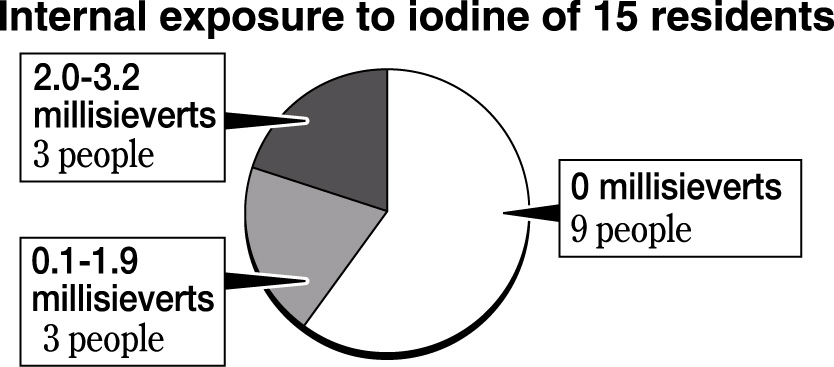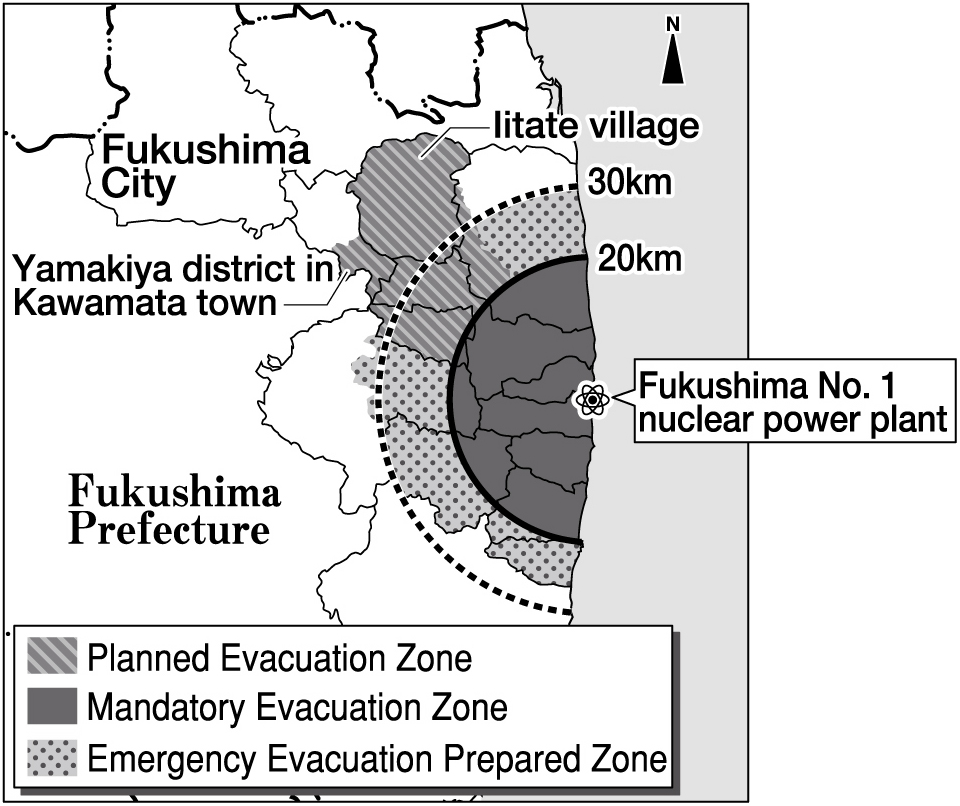Fukushima and Hiroshima: Cesium found in 15 residents shows internal exposure to radiation
Jun. 28, 2011
by Seiji Shitakubo, Staff Writer
On June 23, it was learned that radioactive cesium was detected in the urine of 15 residents of Iitate village and the Yamakiya district in Kawamata town in Fukushima Prefecture. The urine examination was conducted by a team of five experts, including Nanao Kamada, former director of Hiroshima University’s Research Institute for Radiation Biology and Medicine (RIRBM). The findings offer evidence of the fact that local residents have suffered internal exposure to radiation as a result of the nuclear crisis at the Fukushima No. 1 (Daiichi) nuclear power plant. The amount of cesium detected, however, was very small and the team explained: “There is no need for concern as long as residents do not eat contaminated vegetables, or other contaminated foods, in the future.”
The examinees range in age from four to 77, and consist of ten people from Iitate village and five from the Yamakiya district in Kawamata town. Their urine was collected twice, on May 5, 55 days after the nuclear accident, and again towards the end of May. Kiyoshi Shizuma, a professor in the Faculty of Engineering at Hiroshima University, measured the amount of radioactive materials per 100 milliliters of urine.
Cesium was detected in the urine of all the examinees in both tests. However, there was such a minute amount of cesium that it would reportedly be 0.1 millisieverts or below in total even if the radioactive material continues to emit radiation for the next 50 years. With regard to iodine, this substance was detected in six examinees at the time of the first test. The highest level of iodine that was detected was 3.2 millisieverts. But no iodine was detected in any examinee at the time of the second test. It is believed that iodine was discharged with urine, among other means.
Dr. Kamada and Osamu Saito, a doctor at the Watari Hospital in the city of Fukushima, concluded: “As iodine was not detected in some people, it was probably taken in the body by eating contaminated vegetables and mushrooms, not via breathing. Shipments of both food items were banned afterwards. So, on the whole, there is no cause for concern.”
The team of experts also conducted a questionnaire on the behavior of the 15 examinees in the wake of the nuclear crisis. Taking into account the radiation levels in the air around their homes, the team estimated each examinee’s external exposure to radiation up to May 5. The results showed that the highest level of radiation was 13.5 millisieverts, which means that this person, if evacuation did not take place, would be very likely to exceed the government-designated annual limit of 20 millisieverts of radiation. Six people are thought to have suffered 10 millisieverts or more, while eight people are believed to have suffered from 5 to 9.9 millisieverts, and one person appears to have suffered 4.9 millisieverts or less.
(Originally published on June 24, 2011)
“This level of radiation is not a cause for concern,” says former RIRBM director and others
On June 23, it was learned that radioactive cesium was detected in the urine of 15 residents of Iitate village and the Yamakiya district in Kawamata town in Fukushima Prefecture. The urine examination was conducted by a team of five experts, including Nanao Kamada, former director of Hiroshima University’s Research Institute for Radiation Biology and Medicine (RIRBM). The findings offer evidence of the fact that local residents have suffered internal exposure to radiation as a result of the nuclear crisis at the Fukushima No. 1 (Daiichi) nuclear power plant. The amount of cesium detected, however, was very small and the team explained: “There is no need for concern as long as residents do not eat contaminated vegetables, or other contaminated foods, in the future.”
The examinees range in age from four to 77, and consist of ten people from Iitate village and five from the Yamakiya district in Kawamata town. Their urine was collected twice, on May 5, 55 days after the nuclear accident, and again towards the end of May. Kiyoshi Shizuma, a professor in the Faculty of Engineering at Hiroshima University, measured the amount of radioactive materials per 100 milliliters of urine.
Cesium was detected in the urine of all the examinees in both tests. However, there was such a minute amount of cesium that it would reportedly be 0.1 millisieverts or below in total even if the radioactive material continues to emit radiation for the next 50 years. With regard to iodine, this substance was detected in six examinees at the time of the first test. The highest level of iodine that was detected was 3.2 millisieverts. But no iodine was detected in any examinee at the time of the second test. It is believed that iodine was discharged with urine, among other means.
Dr. Kamada and Osamu Saito, a doctor at the Watari Hospital in the city of Fukushima, concluded: “As iodine was not detected in some people, it was probably taken in the body by eating contaminated vegetables and mushrooms, not via breathing. Shipments of both food items were banned afterwards. So, on the whole, there is no cause for concern.”
The team of experts also conducted a questionnaire on the behavior of the 15 examinees in the wake of the nuclear crisis. Taking into account the radiation levels in the air around their homes, the team estimated each examinee’s external exposure to radiation up to May 5. The results showed that the highest level of radiation was 13.5 millisieverts, which means that this person, if evacuation did not take place, would be very likely to exceed the government-designated annual limit of 20 millisieverts of radiation. Six people are thought to have suffered 10 millisieverts or more, while eight people are believed to have suffered from 5 to 9.9 millisieverts, and one person appears to have suffered 4.9 millisieverts or less.
(Originally published on June 24, 2011)








